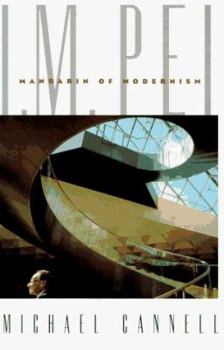I.M. Pei: Mandarin of Modernism
Select Format
Select Condition 
Book Overview
A profile of I.M. Pei, the architectural visionary of such buildings as the Kennedy Library, chronicles his privileged Shanghai upbringing, his Harvard education, and his relationships with famous clients.
Format:Hardcover
Language:English
ISBN:0517799723
ISBN13:9780517799727
Release Date:November 1995
Publisher:Clarkson Potter Publishers
Length:402 Pages
Weight:1.92 lbs.
Dimensions:1.4" x 6.5" x 9.6"
Customer Reviews
3 ratings
Informative & Well-Researched, but Pei Remains a Mystery
Published by Thriftbooks.com User , 16 years ago
This book is not an homage. Neither is it a book written solely for architects or students of architecture. It is instead, a solidly-researched and very readable exploration of the life and works of one of the most famous, yet enigmatic figures occupying the rarefied space of internationally acclaimed architects. Michael Cannell, the author, has stitched together this informative biography through interviews with I.M. Pei's associates, friends and relatives; accounts and references in popular media, and via layman's-level analyses of his works. In this book Pei is revealed, not as a hero, rebel or visionary, but as a consolidator and commercializer of architectural principles, as well as an inspired artist, political sophisticate, and inveterate social climber. Michael Cannel seems well equipped to perform the extensive investigative journalism that underpins this book, as well as to create the layman's explanations of various movements in architecture that the book contains. A graduate of Princeton and the Columbia School of Journalism in the 80s, Cannel has since filled editorial positions at Architecture, Dwell Magazine, Homefront L.A., and for six years the House and Home section of the New York Times. He has also contributed his architectural insights to popular magazines such as The New Yorker, Newsweek, Town & Country, and The Washington Post Magazine. The main thrust of his book is an exposition of I.M. Pei's life from childhood to meritorious old age, organized around the architect's career and works. Along the way however, we are treated to a history of Shanghai in the colonial and post-colonial eras, China's mandarin culture, the development of Modernism, urban renewal in the United States, and other historical asides. While at times welcome, and at other times not-so-welcome, these extensive asides are usually woven back into the main story-line as vehicles that explain Pei's formative influences. This outside-in approach fails however, to reveal much of the man behind the persona, leaving Pei as a seamless, almost hermetic personality. He is described, even as a child, with the same powers of patience, self-possession, persuasion and cheerfulness (among many others) that will be used to describe him throughout the book. This is a weakness for those desiring a more intimate portrayal. I however, don't fault Cannell overly much for this. If many of Pei's closest associates profess not to really know him (and they do), it's hardly surprising that an outside journalist would fare no better. A recurring theme of the book is the depiction of Pei as a modern day mandarin. Representing the 15th generation of a prosperous dynasty of bankers, poets and painters, Pei is heir to millennia-old traditions of conduct passed down by China's ruling class. As the book progressed, I was gradually educated as to the various nuances of meaning attached to this word. A mandarin has self-control, is well mannered, cultured, used to the ways of pow
Helpful insights into so many memorable projects and the man whose vision they were
Published by Thriftbooks.com User , 18 years ago
You know the work of I.M Pei even if you don't know that he was the architect behind them. You have seen the glass Pyramid at the Lourvre (although there was much more to his design than that visible and memorable landmark), the Rock and Roll Hall of Fame, the East Wing of the National Gallery in Washington D. C. , the John F. Kennedy Memorial Library, Hancock Place in Boston, the Bank of China Tower in Hong Kong and many others. Like a great many important architects, he caused strenuous debate, derisive rejection by some, loud praise from others. Many link him as a disciple of Walter Gropious and others reject the very idea that such an original thinker would be derivative of another. This very fine book will help you understand more about his work, how the projects were selected, the requirements and desires behind the designs, and what the vision was that resulted in all those buildings with the sharp geometric lines. The man himself is also quite interesting. The firm he founded continues (though he retired from it in 1990), however, in an interview in 2004 he said that he stopped taking new projects in 2001. He was born in 1917, so he has had a very active and long career. If you think you hate his work, I encourage you to step back and read this book. It will help you better understand his designs. They do make a great deal of sense and I think they are beautiful. Certainly, while they still challenge some, they do seem less outrageous compared to the designs one sees going up around the world today.
A Wonderful Tale
Published by Thriftbooks.com User , 24 years ago
A brilliant and well-thought out look at one of this centuries most prolific architects. All of the stories behind his greatest achievements are here, including the scandal the erupted around the building of the Louvre pyramid. Pei is shown to be an practical innovator with his own particular philosophy; his elegant lines and deceptively simple ideas set him apart from the complicated ideology of the Bauhaus movement and architects like Le Corbusier. A very good read.






